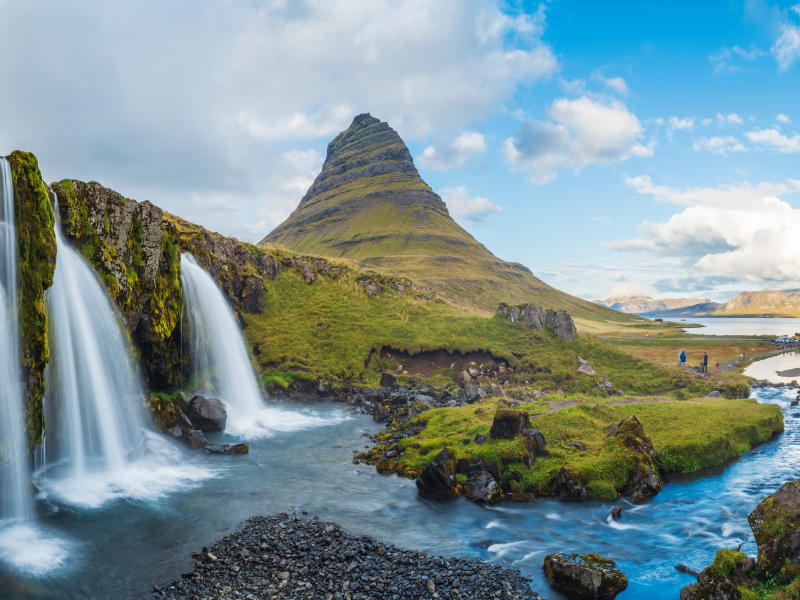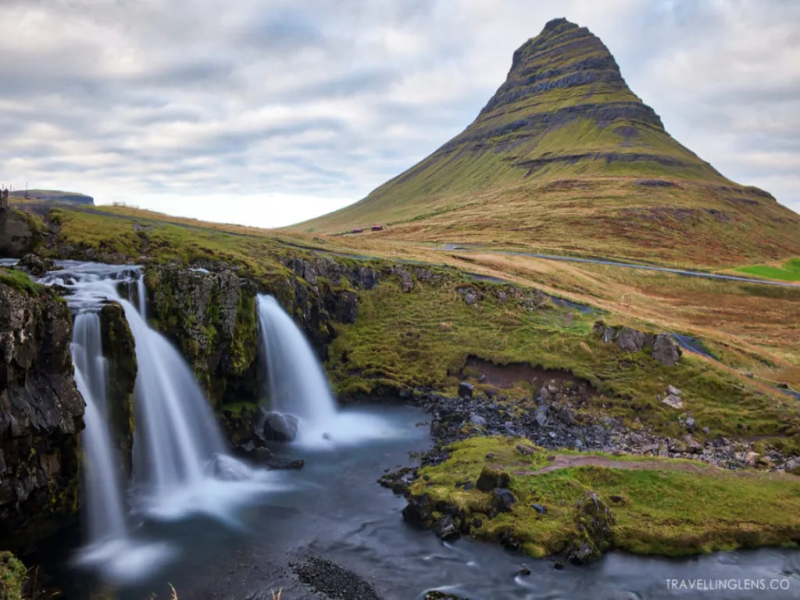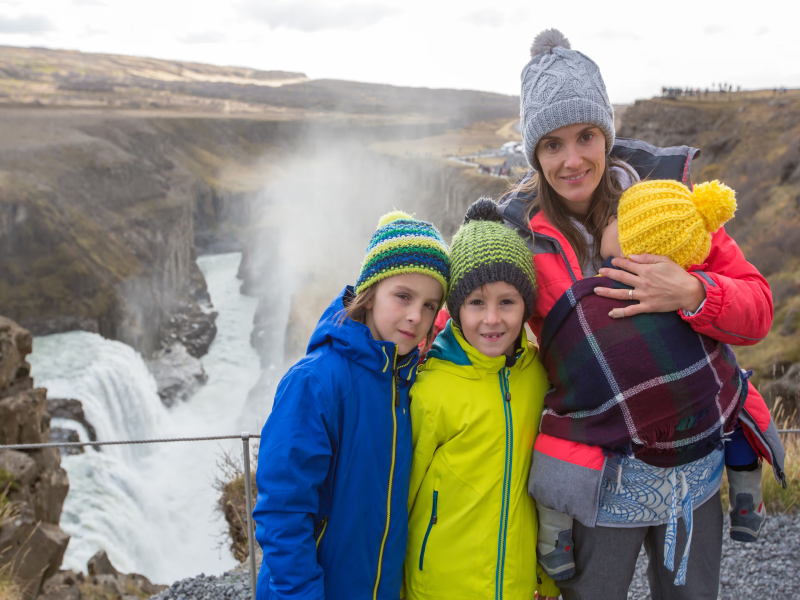Introduction
Kirkjufell is a freestanding mountain in western Iceland, looming over the fishing village of Grundarfjörður, and it has become one of the country’s most photographed mountains because of its special shape. Its own unique conical shape and beautiful scenery make it possible to call it the most photographed mountain in Iceland. But as to why Kirkjufell has become one of the most sought out places for photography and tourists across the globe?
On this article we are going to learn a lot more about the remote location, the underlying rock formations, the history, culture, and other factors that make Kirkjufell stand out. If you are a photography lover or have had the urge to explore Iceland’s phenomenal terrains, this article will give you all the information you need to know around this magnificent natural phenomenon.

The Geographic and Geological Significance of Kirkjufell
Where Is Kirkjufell Located?
Kirkjufell stands on the Snæfellsnes Peninsula better known as a region of Iceland that has a little bit of everything that the country offers. It is situated close to the small town called Grundarfjörður allowing many tourists to visit the mountain during their trip across the peninsula.
- Coordinates: 64.9414° N, 23.3064° W.
- Accessibility: 70 minutes by car to the north-east from the capital of Iceland – Reykjavik (185 km).
Kirkjufell can be accessed by driving on Route 54 which is c ircular path round the peninsula passing through lava fields, fjords and peninsular cliffs. By having other attractions nearby the Snæfellsjökull is ideal when it comes to organising a one day trip or even a longer stay in the Snæfellsnes Peninsula region.
What Makes Kirkjufell’s Shape So Unique?
The silhouette of Kirkjufell is remarkably much like the structure and is commonly referred to as the church-castle or a witch hat. This striking geometry is the result of millions of years of geological activity:
- Glacial Shaping: Geologically, as the age glaciers that shaped kirkjuftel, it has slopes walls and peak that look like those of_landforms_.
- Sedimentary Layers: The layered structural features that characterise the mountain also depict sequences of volcanic ash and sedimentation thus revealing part of Iceland’s volatile geophysical background.
- Elevation: Located at 463 meters (1,519 feet), Kirkjufell is not very high amongst the mountains of Iceland, however due to this mountain standing alone, it offers an un-missed view in the vicinity.
While the other mountains appear to be more ordinary in rising almost sheer from the valleys and fjords, Kirkjufell stands completely from the sea and this offers it a rather otherworldly look depending which side is viewed from. It is this very thing; the shape, size and location of this natural wonder that makes it a perfect attraction for photography and nature enthusiasts.
How Does Kirkjufell Reflect Iceland’s Geology?
Kirkjufell provides a perfect example of Iceland’s dynamic geological past, shaped by volcanic eruptions and glacial activity.
| Feature | Explanation |
| Volcanic Origins | Kirkjufell was formed from lava flows and ash layers. Its rugged surface showcases Iceland’s volcanic roots. |
| Glacial Erosion | The mountain’s sharp ridges and steep cliffs were sculpted by ancient glaciers, which stripped away softer materials. |
| Basalt Columns | The surrounding region features basalt formations, a hallmark of Icelandic geology. |
This makes Kirkjufell not just a photographic marvel but also a living testament to the forces that have shaped Iceland over millennia.
Why Is Kirkjufell So Photogenic?
It will therefore come as no surprise that Kirkjufell stand as being considered as one of the most photographed mount in the entire Iceland. It is a natural beauty that with perfect setting and can be photographed excellently by both professional and beginners. In combination with the Kirkjufellsfoss waterfall situated nearby, the mountain more than offers constant beautiful views to take photos of at any time of day due to its lighting conditions variation.
The Perfect Composition: Kirkjufell and Kirkjufellsfoss Waterfall
One of the most iconic views of Kirkjufell features the mountain perfectly framed by the cascading waters of Kirkjufellsfoss. This small but picturesque waterfall is located just a short walk from the road, making it accessible for visitors year-round.
• Why This Pairing Works:
- The waterfall adds foreground interest, creating depth and balance in photos.
- Kirkjufell’s unique shape contrasts beautifully with the flowing water.
- This scene encapsulates Iceland’s essence: raw, natural beauty combined with dramatic landscapes.
• Best Angles and Viewpoints:
- Classic View: Stand near the base of Kirkjufellsfoss to capture both the falls and the mountain in one frame.
- From the Trail: A short hike uphill provides elevated perspectives, offering alternative compositions.
Photographers often flock to this spot to recreate the classic image, but with variations in light and weather, no two shots are ever the same.
The Magic of Light: Capturing Kirkjufell at Sunrise, Sunset, and Night
The lighting around Kirkjufell changes dramatically throughout the day and night, giving photographers endless creative options.
• Sunrise and Sunset:
- During the golden hours, the mountain glows with warm hues, and the soft light enhances its texture and details.
- The sun’s position varies with the seasons, creating unique opportunities for backlighting or side lighting.
- Pro Tip: Use a wide-angle lens and a tripod to capture long exposures during sunrise or sunset for richer colors.
• Northern Lights:
- Kirkjufell is a prime location for photographing the aurora borealis, particularly during the winter months.
- The mountain’s isolated location minimizes light pollution, offering clear skies on most nights.
- Ideal Months: September to March for peak Northern Lights activity.
• Night Photography:
- The lack of urban lighting makes Kirkjufell a fantastic spot for starry nightscapes.
- Use a fast lens (e.g., f/2.8 or wider) to capture the stars or Milky Way above the mountain.
Seasonal Beauty: Kirkjufell Across the Year
Each season transforms Kirkjufell, offering new and exciting photographic opportunities:
| Season | Highlights | Photography Tips |
| Winter | Snow-capped peaks, frozen waterfalls, and Northern Lights. | Dress warmly and use a polarizing filter to reduce glare. |
| Spring | Melting snow reveals vibrant greenery. | Capture reflections in nearby streams and pools. |
| Summer | Midnight sun creates extended golden hours for photography. | Experiment with soft evening light. |
| Autumn | Golden foliage contrasts with the mountain’s dark basaltic layers. | Use a telephoto lens to capture details of the colors. |
The interplay of light, shadow, and natural elements across seasons ensures that Kirkjufell looks stunning no matter when you visit.
Noteworthy Facts
- Kirkjufell and Instagram: The mountain has been featured in countless travel blogs and social media posts, further solidifying its reputation as a global photography hotspot.
- Award-Winning Photos: Images of Kirkjufell have won numerous landscape photography awards, including National Geographic competitions.
The Cultural and Mythological Significance of Kirkjufell
It is not about geology or simply the beauty that any photographer would die to capture on his lenses; it is also about folklore. Icelanders have been associating nature with mythology for centuries, and, thanks to its shape and majesty, Kirkjufell has probably been the subject of many legends.
What Role Does Kirkjufell Play in Icelandic Folklore?
Icelandic culture is deeply rooted in myths, and Kirkjufell is no exception. Known as “Church Mountain” due to its shape, the peak has long been associated with mystical forces:
• Elves and Hidden People:
- According to Icelandic folklore, Kirkjufell and its surrounding areas are believed to be inhabited by huldufólk (hidden people or elves).
- Icelanders often describe these beings as protectors of nature, and Kirkjufell’s isolation makes it a fitting home for such spirits.
• Troll Legends:
- Some legends suggest that Kirkjufell was once a troll’s stronghold, frozen into its current form by the rising sun.
- Trolls are a recurring theme in Icelandic mythology, often symbolizing nature’s raw and untamable power.
These stories not only add an air of mystery to Kirkjufell but also highlight how Icelanders have historically viewed their landscapes as living, breathing entities.
How Has Kirkjufell Been Represented in Modern Media?
Kirkjufell’s global fame isn’t just due to its natural beauty—it’s also a star in the world of modern media.
• Game of Thrones Connection:
- Kirkjufell gained international recognition when it was featured in HBO’s Game of Thrones.
- In the show, it was depicted as the “Arrowhead Mountain” in scenes beyond the Wall, adding to its dramatic allure.
- This appearance has drawn thousands of fans to the site, further cementing its status as a must-visit destination.
• Documentaries and Photography Competitions:
- Kirkjufell has been the focus of numerous documentaries exploring Iceland’s unique landscapes.
- Its image is frequently used to represent Iceland in travel marketing campaigns, postcards, and photo exhibitions.
• Symbol of Iceland’s Mystique:
- As one of the most recognizable symbols of Iceland, Kirkjufell often features in discussions of the country’s unspoiled wilderness and magical atmosphere.
Cultural Significance Today
More than an assimilation of a natural landscape feature, for Icelanders and other tourists, Kirkjufell is an embodiment of the nation’s encronchment with nature as well as folklore and myths. These stories and references are still appreciate when visiting Kirkjufell thus developing an enhanced endowment with the place.

How to Visit and Photograph Kirkjufell
Located in the Western region of the country it stands out from such other attractions as Kirkjufell since it is easier to access and visit. Whether, it is a layover on a cross country highway, or you allocated a couple of days exploring its grandeur, it is essential to grasp the idea of how to tour and photograph this magnificent Mount.
Getting to Kirkjufell
Kirkjufell is located near the town of Grundarfjörður on the Snæfellsnes Peninsula. Here’s how to plan your journey:
• By Car:
- From Reykjavik, the drive takes approximately 2.5 hours (185 km) via Route 54.
- The route is well-paved and offers scenic views, including lava fields, fjords, and volcanic craters.
- During winter, ensure your vehicle is equipped for icy roads, and check weather forecasts beforehand.
• By Tour:
- Numerous guided tours include Kirkjufell as part of a Snæfellsnes Peninsula itinerary.
- These tours often provide insights into the region’s history, folklore, and geology.
• By Public Transport:
- Public transportation options are limited, so renting a car or joining a tour is recommended.
Best Times to Visit Kirkjufell
Timing your visit can significantly enhance your experience and the quality of your photographs.
| Season | Advantages | Challenges |
| Winter (Nov-Mar) | Snow and Northern Lights create magical scenes. | Roads can be icy; daylight is limited. |
| Spring (Apr-May) | Fewer crowds, waterfalls are full from snowmelt. | Weather can be unpredictable. |
| Summer (Jun-Aug) | Long daylight hours for photography. | Popular with tourists; accommodations may be crowded. |
| Autumn (Sep-Oct) | Rich autumn colors and aurora sightings. | Shorter days; weather can be variable. |
- Golden Hours: Sunrise and sunset provide the soft, warm lighting that enhances Kirkjufell’s features.
- Northern Lights: The aurora borealis is most active between September and March, with clear skies offering the best chance of sightings.
Tips for Photographing Kirkjufell
- Essential Gear:
- Wide-angle lens: Ideal for capturing the mountain and waterfall together.
- Tripod: Ensures stability for long exposures, especially in low light.
- ND filter: Helps achieve smoother water effects in Kirkjufellsfoss.
- Remote shutter release: Avoids camera shake during long exposures.
- Composition Techniques:
- Use Leading Lines: Incorporate paths, streams, or the waterfall to guide the viewer’s eye toward Kirkjufell.
- Rule of Thirds: Position the mountain off-center for a more dynamic composition.
- Foreground Interest: Include the cascading waters of Kirkjufellsfoss or nearby vegetation for added depth.
- Weather Adaptation:
- Cloudy skies can add drama to your shots, while clear skies are perfect for auroras.
- Carry weatherproof gear to protect your equipment from Iceland’s sudden rain showers.
- Ethical Photography:
- Stick to designated paths to preserve the area’s delicate ecosystem.
- Avoid disturbing wildlife or littering the site.
Pro Tips for a Successful Visit
- Arrive early to avoid crowds, especially during the summer months.
- Use apps like Aurora Forecast to time your visit for optimal Northern Lights photography.
- Bring snacks and water, as amenities near the site are limited.

Conclusion: Why Kirkjufell Captivates the World
Kirkjufell is truly worthy of the title of Iceland’s most photographed mountain due to its unique shape, beautiful surroundings of landscape, waterfalls, and flora and fauna, and historical and cultural values that distinguish it from many other physical features found in previously mentioned locations. Its allure lies not only in its beauty but also in the experiences it offers: There is still so much to do in this region – to stand alongside Kirkjufellsfoss while watching Northern Lights above the hill or just admire this icon of Iceland’s landscape during thousands of years.
More on photographers, Kirkjufell is a landscape that transforms season by season and, with changes in light, becomes a canvas for a picture. For tourists it is opportunity to enter to the other world and explore the fascinating Iceland nature. Kickjufell however is not only a location, it is nature’s masterpiece; it is symbolising folklore culture of Iceland; and a call for people to travel with wonder and care is brought by Kickjufell.
It doesn’t matter if you are a professional photographer or just an admirer of the beauty of nature, or maybe Iceland’s charm has attracted you for some other reason, Kirkjufell won’t let you down. In its uniqueness, it named to be a treasure of tourist attraction for all generations when visited conscientiously with respect to its historical backgrounds.
References
- Inspired by Iceland – Iceland’s Landscapes and Folklore.
- National Geographic – “The World’s Best Photography Destinations.”
- Aurora Service – Northern Lights Activity and Forecast.
- Visit Iceland – Travel Tips and Accommodations.




